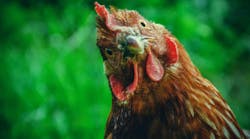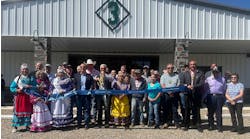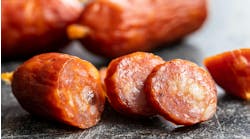Slaughter is the first step in poultry processing, and arguably the most delicate and challenging. It involves taking a stream of living creatures and making sure they get fed efficiently into the system without stressing themselves – or the workers handling them.
Slaughter practices have implications for efficiency, meat quality and an intangible element: our relationship, as human beings, with the animals we use for meat. That’s why an alternative to customary slaughter practices is getting increased attention in America.
Almost all industrial-level poultry slaughter starts with stunning the birds. Electrical stunning, usually through a water bath, is the norm in the U.S. because of its quick throughput and relatively low cost, both capital and operational.
Atmospheric stunning puts poultry to sleep without any of the potential injuries associated with shackling and electric stunning. Photo: Baader
“For a long time, electric water bath stunning has been the only available stunning method in poultry processing,” says Oliver Hahn, CEO of Baader Food Processing North America, which makes both electrical and gas stunning systems. “Because of the small footprint and low cost of ownership, the method is very attractive and easily adapted to the increasing line speeds in the industry.”
Humane gas
The major alternative stunning system doesn’t use electricity at all. Instead, it puts the birds to sleep through controlled use of gas.
Controlled atmosphere stunning (CAS) exposes birds to carbon dioxide, usually increasing levels of it in phases to crowd out oxygen. The birds are rendered unconscious but not dead – the optimal condition for bleeding out.
Crates of incoming chickens await the destacking module of the Marel Atlas system.
The biggest advantage of CAS is that unlike a jolt of electricity, it brings about unconsciousness gradually. This removes the possibility of damage to the meat and is generally considered more humane. That’s why it’s more common in Europe, where animal welfare regulations are more stringent. Another advantage is that it does not require shackling of live birds, which is not only difficult and unpleasant for workers, but can agitate the animals, with implications for meat quality.
Instead, in the Atlas CAS system from Marel, the birds are shipped from the poultry farm in standardized crates that stack on a flatbed truck. The norm is for these trucks to have temporary walls and ceilings that can be erected in cold or inclement weather.
The crates are loaded into the Atlas, which takes them through a tunnel that exposes them to five stages, lasting about a minute each, in which the proportion of carbon dioxide to oxygen is gradually increased until the birds lose consciousness.
“Looking through windows along the entire tunnel, we can check the broilers' behavior during the in-line stunning process. They stay calmly at their place,” says Tim van Schaik, product specialist for live bird handling at Marel. “Our CAS system gently stuns the broilers within five minutes.”
CAS systems from Baader come in above- and below-ground versions. The below-ground one descends the crates into stages where the CO2 is gradually increased. Having the system below ground means a smaller footprint. It’s also somewhat safer, since CO2, being heavier than oxygen, will stay below ground instead of seeping out. On the other hand, below-ground systems are harder to install and to access for cleaning and maintenance.
A worker checks on the progress of chickens being processed through Marel’s Atlas SmoothFlow system.
Perdue Farms has made a commitment to eventually using CAS in all its operations. It started with an investment of more than $15 million in a Marel Atlas system for its plant in Milford, Del., in 2018. Perdue had to build out an area of the plant to establish enough space to receive the birds, remove the existing electrical stunning system, install the Marel CAS and also install a sanitation system to wash and handle the crates the live chickens arrive in.
“Implementation of this CAS system is a significant step in our company’s animal care journey, and Perdue is the only major poultry company in the country to commit to converting 100 percent of its plants to CAS,” says Diana Souder, Perdue’s director of corporate communications.
Looking for credit
CAS can be sped up if necessary by increasing the concentration of CO2. But in general, CAS systems can’t match the line speeds of electrical stunning. That, and their higher capital and operational costs, are their biggest disadvantages.
One advantage goes beyond operational considerations. Humane slaughter is a goal of animal-rights organizations throughout the world; using a CAS is a way for a chicken processors to burnish their credentials in that regard.
It is, however, debatable how much market value that really has. Animal welfare claims with consumer appeal, like cage-free hens, deal almost exclusively with living animals. Humane slaughter methods probably won’t resonate with consumers, simply because they find the whole subject unpleasant.
Religion in the Abattoir
Poultry meant to be consumed according to either Jewish or Islamic dietary laws has to be slaughtered under the rules of those religions. These place restrictions on slaughtering that are incompatible with modern, secular methods.
The rules of kosher slaughter, called shechita, forbid stunning the birds beforehand. The usual method is for one worker to hold the chicken and another to slice its throat using a special, very sharp blade called a chalaf. The theory is that if both workers are sufficiently skilled, the bird will remain calm and experience little or no pain.
Islamic rules are the subject of some interpretation, says Timothy Hyatt, managing director of Islamic Services of America, a halal certification agency. Some authorities say electrical stunning is not halal; others permit it as long as it leaves the bird alive prior to the cut, without an irreversible loss of consciousness. The question of controlled atmosphere stunning is “something that hasn’t been fleshed out yet,” Hyatt says.
Both kosher and halal slaughter have come under criticism from animal rights activists. Practitioners have pushed back, saying these methods are as humane as regular high-speed slaughter.
Mimi Stein, executive director of the nonprofit organization Certified Humane, called humane slaughter “not part of the common conversation” and is dubious about its consumer appeal: “In my experience it is an uncomfortable subject for consumers to talk about or even think about.” (Certified Humane doesn’t have a preference between electrical and atmospheric stunning, as long as the procedure is done correctly, including proper handling before stunning, Stein says.)
The more practical appeal of humanely slaughtered birds is to trade customers, like foodservice chains or retailers, who have animal welfare as a priority. McDonald’s Corp. declares on its corporate website that it is “taking a whole-system approach that considers everything from housing and husbandry to humane slaughter.”
Whole Foods has a goal of 100% CAS-slaughtered chicken by 2026, with exceptions for small processors, which might not be able to afford a CAS system, and kosher operations.
A greater motivation would be governmental animal-welfare regulations. These tend to be more stringent in Europe than America, which is why CAS is more common there.
Slaughtering technology has evolved to face a wide variety of interests, concerns and requirements. Getting that first step right will make things go more smoothly down the line.


